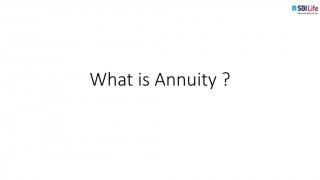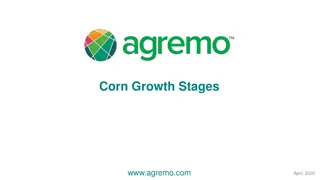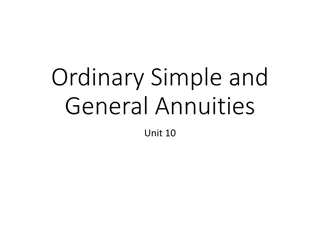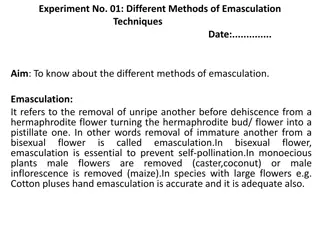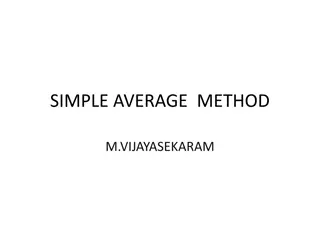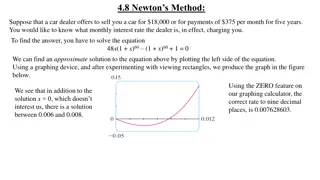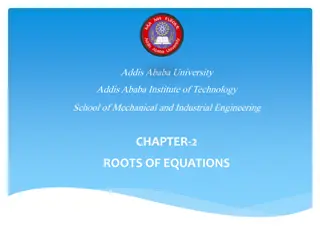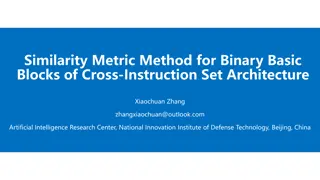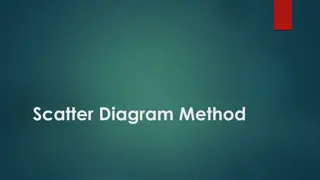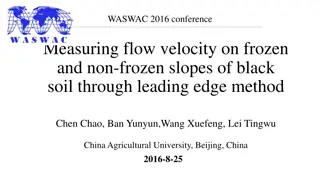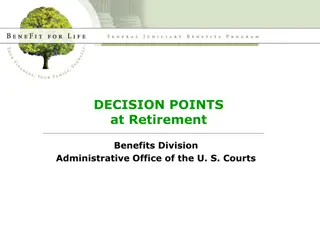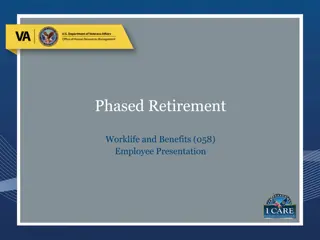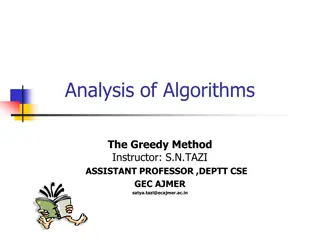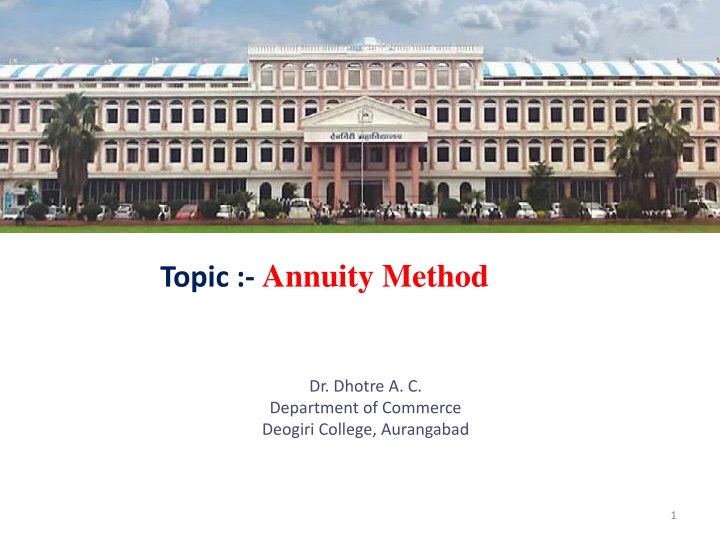
Annuity Method of Depreciation
Explore the annuity method of depreciation, a unique approach to allocating asset costs and interest lost over its useful life. Learn how this method works, its benefits, drawbacks, and suitability for long-term assets like property and buildings.
Download Presentation

Please find below an Image/Link to download the presentation.
The content on the website is provided AS IS for your information and personal use only. It may not be sold, licensed, or shared on other websites without obtaining consent from the author. If you encounter any issues during the download, it is possible that the publisher has removed the file from their server.
You are allowed to download the files provided on this website for personal or commercial use, subject to the condition that they are used lawfully. All files are the property of their respective owners.
The content on the website is provided AS IS for your information and personal use only. It may not be sold, licensed, or shared on other websites without obtaining consent from the author.
E N D
Presentation Transcript
Topic :- Annuity Method Dr. Dhotre A. C. Department of Commerce Deogiri College, Aurangabad 1
Annuity Method As we all know that depreciation is the decrease in the value of assets. In other words, it can be said that it is a method of allocating the cost of the asset over its useful life. However, at the end of the accounting year, depreciation is charged to the Profit and Loss A/c. Annuity method of depreciation is also another method of depreciation apart from other methods like the straight-line method, written down value method, etc. Annuity Method This method of depreciation considers the cost of the asset and also the amount of interest lost on the capital expenditure. Thus, it is based on the assumption that if the amount that is spent on the purchase of the asset was invested elsewhere, it would have earned a certain amount of interest.
How the Annuity Method of Depreciation Works The annuity method of depreciation is also referred to as the compound interest method of depreciation. If the cash flow of the asset being depreciated is constant over the life of the asset, then this method is called the annuity method. However, the annuity method of depreciation is not endorsed under generally accepted accounting principles. Many methods of measuring depreciation fail to take into account the interest lost on capital invested in an asset; the annuity method of depreciation makes up for this deficiency. The annuity method assumes that the sum spent on buying an asset is an investment that should be expected to yield interest.
Annuity Method Therefore, not only the cost of the asset should be allocated but also the amount of interest on it should be allocated over the useful life of the asset. In other words, this method determines the internal rate of return (IRR) on the cash flows of the asset. Thus, the amount of depreciation is calculated using the Annuity Tables. The capital expenditure and interest accruing thereof are written off during the life of the asset. The amount of depreciation every year is constant. But, the interest charged in the initial years is more and that in later years is less. Hence, the amount of capital expenditure charged is less in the initial years and it is more in later years. This method is suitable in case of long-term leases. On the contrary, it is not suitable where there are frequent additions or deductions in the asset because then the calculation of depreciation becomes difficult.
The annuity method of depreciation is useful for assets that have a high initial cost and a long life span, such as property and buildings secured under leases. Some disadvantages of using this method are that it can be difficult to understand and that it may require frequent recalculations depending on the asset. Also, it can be burdensome to profit and loss accounting over time, as the level of depreciation diminishes with every year.
Illustration: 1 A firm purchases a 5-year lease for Rs.30, 000. It decided to write off depreciation on the annuity method, presuming the rate of interest to be 5% per annum. If annuity of Re. 1 for 5 years at 5% is 0.230975, show the Lease Account for full period. Solution: The amount of depreciation to be charged every year = 0.230975 x 30000 1
Lease Account Date Particulars Amounts Date Particulars Amounts 1st Year 1st Year To Bank A/C To Interest A/C 30000 1500 31500 By Depreciation By Balance C/D 6929.25 24570.75 31500.00 2nd Year 2nd Year To Balance b/d To Interest A/C 24570.75 1228.54 25799.29 By Depreciation By Balance C/D 6929.25 18870.04 25799.29 3rd Year 3rd Year To Balance b/d To Interest A/C 18870.04 943.50 19,813.54 By Depreciation By Balance C/D 6929.25 12884.29 19,813.54 4th Year 4th Year To Balance b/d To Interest A/ 12884.29 644.21 13528.50 By Depreciation By Balance C/D 6929.25 6599.25 13528.50 5th Year 5th Year By Depreciation To Balance b/d 6599.25 330 6929.25 6929.25 6929.25
Illustration: 2 A firm purchases a 4-year lease for Rs.100, 000. It decided to write off depreciation on the annuity method, presuming the rate of interest to be 4% per annum. If annuity of Re. 1 for 4 years at 4% is 0.360349, show the Lease Account for full period. Solution: The amount of depreciation to be charged every year = 0.275490 x 100,000 = Rs. 27549
Illustration: 3 A firm purchases a 4-year lease for Rs.100,000. It decided to write off depreciation on the annuity method, presuming the rate of interest to be 5% per annum. If annuity of Re. 1 for 4 years at 5% is 0.282012, show the Lease Account for full period. Solution: The amount of depreciation to be charged every year = 0.282012 x 100,000 = Rs. 28201
Date Particulars Amounts Date Particulars Amounts 1st Jan 31st Dec 31st Dec To Bank A/C To Interest A/C 100000 5000 105000 By Depreciation By Bal c/d 28201 76799 105000 1st Jan 31st Dec 31st Dec To Bal b/d To Interest A/C 76799 3839.95 80638.95 By Depreciation By Bal c/d 28201 52437.95 80638.95 1st Jan 31st Dec 31st Dec To Bal b/d To Interest A/C 52437.95 2621.89 55059.84 By Depreciation By Bal c/d 28201 26858.84 55059.84 1st Jan 31st Dec 31st Dec To Bal b/d To Interest A/C 26858.84 1342.16 28201.00 By Depreciation 28201 28201.00
Illustration: 4 A company acquires s lease costing Rs. 100000 for a term of five years. You have to find from the Annuity Table that in order to write off the lease on the annuity method at 13% per annum interest, the amount to be written off annually works out to be Rs. 0.2843145 for every rupee. Prepare the Lease Account for all the five years and show the annual charge to Profit and Loss Account during each of these five years. Solution: Calculation of Annual Depreciation If the cost is Re. 1 . Annual Depreciation is Re. 0.2843145 If the cost is Rs. 100000 ..? 0.2843145*100000 1 = 28,431.45
Lease Account Date Particulars Amounts Date Particulars Amounts 1st Jan 31st Dec To Bank A/C To Interest A/C 100000 13000 113000 31st Dec. Year By Depreciation By Balance C/D 28,431.45 84568.55 113000.00 1st Jan 31st Dec To Balance b/d To Interest A/C 84568.55 10993.91 95562.46 31st Dec. Year By Depreciation By Balance C/D 28,431.45 67,131.01 95562.46 1st Jan 31st Dec To Balance b/d To Interest A/C 67,131.01 8727.03 75858.04 31st Dec. Year By Depreciation By Balance C/D 28,431.45 47,426.59 75858.04 1st Jan 31st Dec To Balance b/d To Interest A/C 47,426.59 6,165.45 53592.04 31st Dec. Year By Depreciation By Balance C/D 28,431.45 25,160.59 53592.04 1st Jan 31st To Balance b/d To Interest A/C 25,160.59 3,270.86 31st Dec. By Depreciation 28,431.45
Statement showing net charge against profit Years Depreciation (Debited) 28,431.45 28,431.45 28,431.45 28,431.45 28,431.45 Interest (Credited) 13,000 10993.91 8727.03 6,165.45 3,270.86 Net Charge Against Profit 1 15,431.45 2 17,437.54 3 19,704.42 4 22,266.00 5 25160.59
Illustration: 5 Mohan acquired on lease basis a building for Rs. 10,000 for five years from 1st January, 1985. he decided to provide for depreciation by annuity method charging interest at 10% per annum. The annuity table shows that an investment of Re. 1 at 10% for five years yields Re. 0.2638 every year for five years. Books are closed on 31st December each year. Show 1. Calculation of annual depreciation 2. Lease account for five years. Solution: Calculation of Annual Depreciation If the cost is Re. 1 . Annual Depreciation is Re. 0.2638 If the cost is Rs. 10000 ..? 0.2638*10000 1 = 2638
Lease Account Date Particulars Amounts Date Particulars Amounts 1st Jan 31st Dec To Bank A/C To Interest A/C 100000 13000 113000 31st Dec. Year By Depreciation By Balance C/D 28,431.45 84568.55 113000.00 1st Jan 31st Dec To Balance b/d To Interest A/C 84568.55 10993.91 95562.46 31st Dec. Year By Depreciation By Balance C/D 28,431.45 67,131.01 95562.46 1st Jan 31st Dec To Balance b/d To Interest A/C 67,131.01 8727.03 75858.04 31st Dec. Year By Depreciation By Balance C/D 28,431.45 47,426.59 75858.04 1st Jan 31st Dec To Balance b/d To Interest A/C 47,426.59 6,165.45 53592.04 31st Dec. Year By Depreciation By Balance C/D 28,431.45 25,160.59 53592.04 1st Jan 31st To Balance b/d To Interest A/C 25,160.59 3,270.86 31st Dec. By Depreciation 28,431.45
Illustration: 6 The Asian Ltd. acquired on lease basis a property for Rs. 37910 for 5 years from 1st January, 1985. the company decided to depreciate the lease by annuity method charging interest at 10% per annum. Annuity table shows that an investment of Rs. 3.791 at 10% p.a. yields Re. 1 per year for five years. The company closes the books on 31st December each year. Show 1. Calculation of annual depreciation 2. Lease account for five years. Solution: Calculation of Annual Depreciation If the cost is Rs 3.791 . Annual Depreciation is Re. 1 If the cost is Rs. 37910 ..? 37910 *1 3.791 = 10000
Lease Account Date Particulars Amounts Date Particulars Amounts 1st Jan 1985 31st Dec85 To Bank A/C To Interest A/C 37910 3791 41701 31st Dec. 1985 By Depreciation By Balance c/d 10000 31701 41701 10000 24871.10 34871.10 1st Jan 1986 31st Dec 86 To Balance b/d To Interest A/C 31701 3170.10 34871.10 31st Dec. 1986 By Depreciation By Balance c/d 31st Dec. 1987 1st Jan 1987 31st Dec 87 To Balance b/d To Interest A/C 24871.10 2487.11 27358.21 By Depreciation By Balance c/d 10000 17358.21 27358.21 31st Dec. 88 1st Jan 1988 31st Dec88 To Balance b/d To Interest A/C 17358.21 1735.82 19094.03 By Depreciation By Balance c/d 10000 9094.03 19094.03 31st Dec. 89 By Depreciation 10000 1st To Balance b/d 9094.03
Illustration: 7 Anish acquired, on lease basis, an office premises for Rs. 50000 for 4 years from 1st January, 1985. they decided to provide for depreciation by annuity method charging interest at 10% per annum. The annuity table shows that an investment of re. 1 at 10% p.a. for 4 years yields re. 0.3155 every year for 4 years. Books are closed on 31st December each year. Show 1) Calculation of annual depreciation 2) Lease account for 4 years
Illustration: 7 On 1st January, 1985, Sharma brothers acquired on lease an office building for 4 years for Rs. 63000. the legal expenses in connection with the lease agreement to Rs. 400. they decided to write off the lease by annuity method charging interest at 10% p.a. the annuity table shows that the present value of Re. 1 for 4 years at 10% p.a. is Rs. 3.170. Sharma brothers maintain their books on calendar year basis. Show: 1. Calculation of annual depreciation 2. Lease account for 4 years 3. Entries in L & L A/C for 4 years Solution: Calculation of Annual Depreciation If the cost is Rs 3.170 . Annual Depreciation is Re. 1 If the cost is Rs. 63400 ..? . 63400 *1 3.170 = 20000
Lease Account Date Particulars Amounts Date Particulars Amounts 1985 Jan. 1 Dec. 31 To Bank A/C 63400 6340.00 69740.00 1985 By Depreciation By Bal c/d 20000 49740.00 69740.00 To Interest A/C Dec. 31 1986 Jan. 1 Dec. 31 1986 Dec. 31 To Bal b/d To Interest A/C 49740.00 4974.00 54714.00 By Depreciation By Bal c/d 20000 34714.00 54714.00 1987 Jan. 1 Dec. 31 1986 Dec. 31 To Bal b/d To Interest A/C 34714.00 3471.40 38185.40 By Depreciation By Bal c/d 20000 18185.40 38185.40 1988 Jan. 1 Dec. 31 To Bal b/d To Interest A/C (Rs. 3.94) Adjusted 18185.40 1814.60 20000.00 1986 Dec. 31 By Depreciation 20000 20000.00
P and L A/C Date Particulars Amounts Date Particulars Amounts 31 Dec. 1985 To Depreciation 20000 31 Dec. 1985 By Interest A/C 6340.00
Sinking Fund Method Sinking Fund method is used when the cost of replacement of an asset is too large. Depreciation is charged every year to the profit and loss A/c. But, it may sometimes happen that the amount is not readily available at the time of purchase of the new asset. Thus, the sinking fund method is used. Under this method, the amount of depreciation charged every year is transferred to the sinking fund account. This amount is then invested in Government securities. Also, the interest earned on these securities is reinvested. The amount of depreciation to be charged every year is calculated after considering the element of interest. The interest will be earned on the amount which is invested every year and will remain invested till the useful life of the asset.
Sinking Fund Method At the time of the replacement of the asset, the investment is sold and the new asset is purchased from the sale proceeds. At this time, the book value of the old asset that needs to be replaced is transferred to the Sinking Fund Account. Also, the sale proceeds of the old asset and any profit or loss from the sale of investments are transferred to the Sinking Fund Account. The balance in the Sinking Fund Account is then transferred to the Profit and Loss A/c or General Reserve. The annual amount of depreciation to be charged is calculated with the help of Sinking Fund Tables. These tables show that at a given rate of interest and for a certain period how much amount needs to be set aside so that it accumulates to 1.
Sinking Fund Method However, this method is a complex method of accounting. As the rates of interest keep fluctuating, therefore, the amount accumulated in the sinking fund may not match the original cost of the asset. Also, the cost of replacement of the old asset may also change over the period. This method is mostly used by large-scale industries that have long-term assets and for real estate assets and leases.
Journal Entries for Sinking Fund Method Depreciation A/c .Dr. xx To Sinking Fund A/c .. xx (Being depreciation on the asset transferred to the sinking fund account) Profit and Loss A/c .Dr. xx To Depreciation A/ ..xx (Being depreciation charged to the profit and loss A/c) Sinking Fund Investment A/c Dr. xx To Bank A/c . Xx (Being amount of depreciation invested)
Journal Entries for Sinking Fuund Method Bank A/c .Dr. xx To Interest on Sinking Fund Investment A/c .xx (Being interest earned on the sinking fund investments)
Journal Entries for Sinking Fuund Method Bank A/C Dr. xx Depreciation fund A/C Dr. xx To Dep. Fund Invt. A/C .xx (Being sale of investment on loss) Bank A/C Dr. xx To Depreciation fund A/C xx To Dep. Fund Invt. A/C .xx (Being sale of investment on profit)
Illustration: 1 On the 1st January, 1985, the Asian Ltd. acquired a leasehold property for Rs. 50000 for a period of three years. The company decided to provide for its replacements by setting up a depreciation fund. The expected rate of return on investments is 10% p. a. The Sinking fund table shows that an annual payment of Re. 0.30211 at 10% p.a. compound interest will amount to Re. 1 in 3 years. On 31st December, 1987 the investments were sold at book value. Solution: Calculation of Annual Depreciation If amount required for replacement is Re.1 Annual provision is Re.0.30211 If amount required for replacement is Rs.50000 Annual provision ? 0.30211*50000/1 = 15105.50
Dep. Fund Account Date Particulars Amounts Date Particulars Amount s 15105.50 15105.50 1985 Dec. 31 To Bal c/d 1985 Dec. 31 By P and L A/C 15105.50 15105.50 15105.50 1510.55 15105.50 31721.55 1986 Dec. 31 To Bal c/d 31721.55 1986 Jan. 1 Dec. 31 By bal b/d By Bank A/C (Intt.) By P and L A/C 31721.55 1987 Dec.31 To leasehold property A/C 50000 1987 Jan. 1 Dec. 31 By bal b/d By Bank A/C (Intt.) By P and L A/C 31721.55 3172.16 15106.29 50000.00 50000.00
Dep. Fund Investment Account Date Particulars Amounts Date Particulars Amount s 15105.50 15105.50 1985 Dec. 31 To Bank A/C 1985 Dec. 31 By Bal c/d 15105.50 1986 Jan. 1 Dec. 31 To bal b/d To Bank A/C (15105.50+1510.55) 1986 Dec. 31 By Bal c/d 31721.55 16616.05 31721.55 31721.55 1987 Jan. 1 To bal b/d 31721.55 1987 Dec. 31 By bank A/C 31721.55 31721.55 31721.55
Lease hold Property Account Date Particulars Amounts Date Particulars Amount s 1985 Jan. 1 To Bank A/C 50000 1985 Dec. 31 By Bal c/d 50000 50000 50000 1986 Jan. 1 To bal b/d 50000 1986 Dec. 31 By Bal c/d 50000 50000 50000 1987 Jan. 1 To bal b/d 50000 1987 Dec. 31 By Dep. Fund A/C (Transfer From) 50000 50000 50000
Illustration: 1 On the 1st January, 1985, the National Ltd. bought a plant for Rs. 110000 for a period of four years. The plant have a scrap value of Rs.10000 at end of its useful life. The company decided to provide for its replacements by setting up a depreciation fund. The expected investments will earn interest at 10% p. a. The Sinking fund table shows that an annual payment of Re. 0.21547 invested each year will produce Re. 1 end four years at 10% p.a. On 31st December, 1988 the balance at bank Rs. 50000 and the investments were sold for R. 70000. a new plant purchased for Rs. 125000. the scrap of the old plant realized Rs. 12000. Solution: Calculation of Annual Depreciation If amount required for replacement is Re.1 Annual provision is Re. 0.21547 If amount required for replacement is Rs.50000 Annual provision ? 0.21547 * 100000 /1 = 21547.00
Dep. Fund Account Date Particulars Amounts Date Particulars Amount s 21547.00 21547.00 1985 Dec. 31 To Bal c/d 1985 Dec. 31 By P and L A/C 21547.00 21547.00 45248.70 21547.00 2154.70 21547.00 45248.70 1986 Dec. 31 To Bal c/d 1986 Jan. 1 Dec. 31 By bal b/d By Bank A/C (Intt.) By P and L A/C 45248.70 45248.70 4524.87 21547.00 71320.57 1987 Dec.31 To Bal c/d 71320.57 1987 Jan. 1 Dec. 31 By bal b/d By Bank A/C (Intt.) By P and L A/C 71320.57 1987 Jan. 1 Dec. 1320.57 By bal b/d By Bank A/C (Intt.) 71320.57 7132.05
Dep. Fund Investment Account Date Particulars Amounts Date Particulars Amount s 21547.00 21547.00 1985 Dec. 31 To Bank A/C 1985 Dec. 31 By Bal c/d 21547.00 21547.00 45248.70 21547.00 1986 Jan. 1 Dec. 31 To bal b/d To Bank A/C (21547.00+2154.70) 1986 Dec. 31 By Bal c/d 23701.70 45248.70 45248.70 45248.70 1987 Jan. 1 To bal b/d To Bank A/C (21547.00+4524.87) 1987 Dec. 31 By Bal c/d 71320.57 26071.87 71320.57 71320.57 1987 Jan. 1 To bal b/d 71320.57 1987 Dec. 31 By Bank (Sale) 70000 1320.57 71320.57 71320.57
Plant Account Date Particulars Amounts Date Particulars Amounts 1985 Jan. 1 To Bank A/C (Purchase) 110000 1985 Dec. 31 By bal c/d 110000 110000 110000 1986 Dec. 31 1986 Jan. 1 To bal b/d 110000 By bal c/d 110000 110000 110000 1987 Dec. 31 1987 Jan. 1 To bal b/d 110000 By bal c/d 110000 110000 110000 1988 Jan. 1 Dec. 31 To bal b/d To P and L A/c To Bank A/C 110000 679.43 125000 1988/ Dec. 31 By bank A/C (Scrap Sold) By Dep. Fund A/C (Accumulated Dep.) By bal c/d 12000 98679.43 125000 135679.43 135679.43
Depreciation Account Date Particulars Amounts Date Particulars Amounts 21547.00 21547.00 1985 Dec. 31 To Sinking Fund A/c 1985 Dec. 31 By P and L A/C 21547.00 21547.00 1986 Dec. 31 1986 Dec. 31 21547.00 21547.00 To Sinking Fund A/c By P and L A/C 21547.00 21547.00 1987 Dec. 31 1987 Dec. 31 21547.00 21547.00 To Sinking Fund A/c By P and L A/C 21547.00 21547.00 1988 Dec. 31 1988 Dec. 31 21547.38 21547.38 To Sinking Fund A/c By P and L A/C
Interest on Depreciation Account Date Particulars Amounts Date Particulars Amounts 2154.70 2154.70 1986 Dec. 31 To Sinking Fund A/c 1986 Dec. 31 By P and L A/C 2154.70 2154.70 1987 Dec. 31 1987 Dec. 31 4524.87 4524.87 To Sinking Fund A/c By P and L A/C 4524.87 4524.87 1988 Dec. 31 1988 Dec. 31 7132.06 7132.06 To Sinking Fund A/c By P and L A/C 7132.06 7132.06
Illustration: 1 On the 1st January, 1985, the National Ltd. bought a plant for Rs. 110000 for a period of four years. The plant have a scrap value of Rs.10000 at end of its useful life. The company decided to provide for its replacements by setting up a depreciation fund. The expected investments will earn interest at 10% p. a. The Sinking fund table shows that an annual payment of Re. 0.21547 invested each year will produce Re. 1 end four years at 10% p.a. On 31st December, 1988 the balance at bank Rs. 50000 and the investments were sold for R. 70000. a new plant purchased for Rs. 125000. the scrap of the old plant realized Rs. 12000. Solution: Calculation of Annual Depreciation If amount required for replacement is Re.1 Annual provision is Re. 0.21547 If amount required for replacement is Rs.50000 Annual provision ? 0.21547 * 100000 /1 = 21547.00
Illustration: 1 Solution: Calculation of Annual Depreciation If amount required for replacement is Rs. 5 Annual provision is Re. 0.904875 If amount required for replacement is Rs.140000 Annual provision ? 0.904875 * 140000 /5 = 25336.5
25336.50 25336.50 2014 Dec. 31 To Bal c/d 2014 Dec. 31 By P and L A/C 25336.50 25336.50 25336.50 1266.82 25336.50 51939.82 Dec. 31 2015 To Bal c/d 2015 Jan. 1 Dec. 31 By bal b/d By Bank A/C (Intt.) By P and L A/C 51939.82 2596.99 25336.50 79873.31 2016 Dec. 2016 Jan. 1 By bal b/d By Bank A/C (Intt.) By P and L A/C To Bal c/d 79873.31 79873.31 2017 Jan. 1 By bal b/d By Bank A/C (Intt.) By P and L A/C 79873.31 3993.66 25336.50 109203.47 109203.47 2017 To Bal c/d 109203.47 2018 Jan. 1 Dec. 31 109203.47 5460.17 25336.36 14000.00 By bal b/d By Bank A/C (Intt.) By P and L A/C (Adj.0.14) 140000.00 2018 Dec. 31 To Lease Account 140000.00
Date Particulars Amounts Date Particulars Amount Dep. Fund Investment Account s 25336.50 25336.50 2014 Dec. 31 To Bank A/C 2014 Dec. 31 By Bal c/d 25336.50 25336.50 25336.50 26603.32 51939.82 51939.82 2015 Jan. 1 Dec. 31 To bal b/d To Bank A/C 25336.50+1266.82 2015 Dec. 31 By Bal c/d 51939.82 51939.82 79873.31 2016 Jan. 1 Dec. 31 To bal b/d To Bank A/C (25336.50+2596.99) 2016 Dec. 31 By Bal c/d 27933.49 79873.31 79873.31 79873.31 2017 Jan. 1 To bal b/d To Bank A/C (25336.50+3993.66) 2017 Dec. 31 By Bal c/d 109203.4 7 29330.16 109203.47 2018 Jan. 1 109203.4 7 1987 Dec. 31 To bal b/d 109203.47 By Bank (Sale) 109203.4 7
Solution: Calculation of Annual Depreciation If amount required for replacement is Re.1 Annual provision is Re.0.21547 If amount required Rs.165000 Annual provision ? 165000 * 0.21547 /1 = 35552.55 for replacement is
Dep. Fund Account Date Particulars Amounts Date Particulars Amounts 35552.55 35552.55 31st Dec. 31st Dec. 2014 To Bal c/d By P and L A/C 35552.55 35552.55 2014 35552.55 3555.26 35552.55 74660.36 1st Jan 2015 31st Dec. 2015 31st Dec. By bal b/d By Bank A/C (Intt.) By P and L A/C To Bal c/d 74660.36 74660.36 31st Dec. 2016 1st Jan 2016 31st Dec. To Bal c/d 117678.94 By bal b/d By Bank A/C (Intt.) By P and L A/C 74660.36 7466.03 35552.55 117678.94 117678.94 12678.94 152321.06 31st Dec. 2017 1st Jan 2017 31st Dec. To Dep Fund Invt. A/C To machinery By bal b/d By Bank A/C (Intt.) By P and L A/C 117678.94 11767.89 35553.17 165000.00 165000.00
Dep. Fund Investment Account Date Particulars Amounts Date Particulars Amounts To Bank A/C 35552.55 35552.55 31st Dec. 2014 31st Dec. 2014 By Bal c/d 35552.55 35552.55 1st Jan 2015 31st Dec. 35552.55 39107.81 74660.36 To bal b/d To Bank A/C (35552.55+3555.26) 2015 31st Dec. By Bal c/d 74660.36 74660.36 1st Jan 2016 31st Dec. By Bal c/d To Bank A/C (35552.55+7466.03) 74660.36 2016 31st Dec. By Bal c/d 117678.94 43018.58 117678.94 117678.94 105000.00 12678.94 117678.94 1st Jan 2017 31st Dec. 31st Dec. 2017 By Bal c/d 117678.94 By bank A/C (Sold) 117678.94


